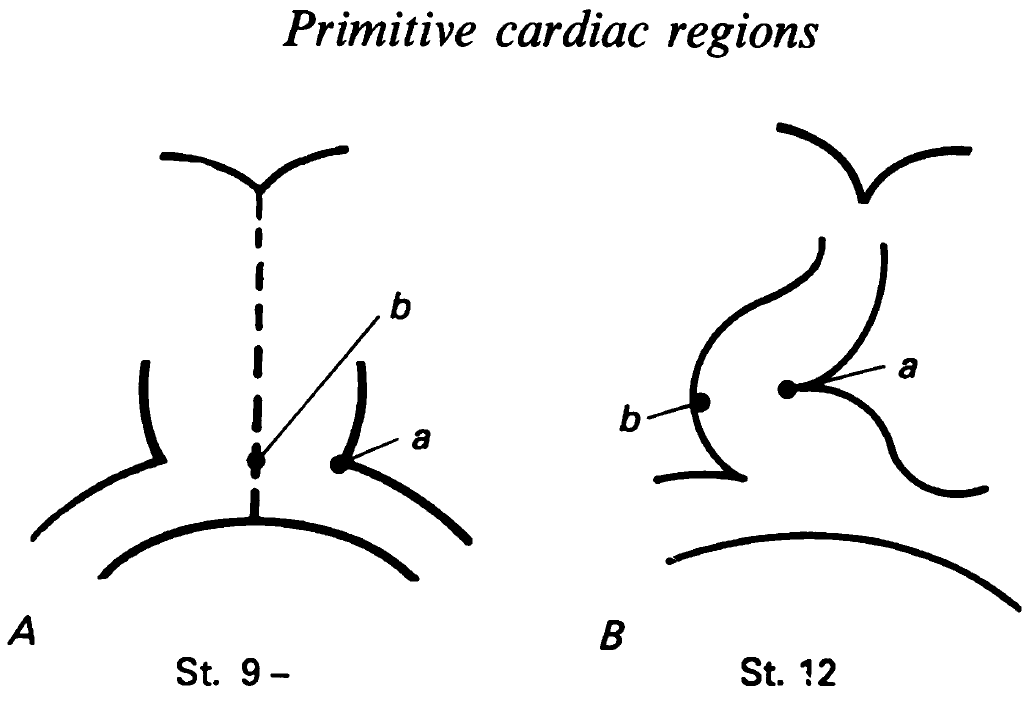Forgotten classics: Tracing the heart
Posted by the Node, on 17 August 2016
de la Cruz, M.V., Sánchez-Gómez, C. & Palomino, M.A. (1989) The primitive cardiac regions in the straight tube heart (Stage 9–) and their anatomical expression in the mature heart: an experimental study in the chick embryo. Journal of Anatomy 165: 121-131.
Recommended by Benoit Bruneau, Gladstone Institute for Cardiovascular Disease
Two previous posts in this series featured papers on cell lineage, with genetic mosaics revealing the three germ layers of the plant meristem and the progressive determination of cells in the fly leg. Given how fundamental cell lineage is to developmental biologists – “the thread that holds development together and arguably the most important concept in developmental biology” – it is not surprising that it appears again in this month’s Forgotten Classic, a 1989 paper from Maria de la Cruz and colleagues on heart development.
Heart development is a complex process involving numerous cell types and different morphogenetic events to make an organ that begins its vital function long before it reaches its final, intricate shape. That this process is error prone is borne out by the high prevalence of congenital heart defects in humans. For de la Cruz, a Cuban cardiac embryologist who spent most of her career in Mexico City, a precondition for understanding the aetiology of congenital defects was a comprehensive description of normal heart development. She was particularly preoccupied with the question of where the various parts of the final (or ‘definitive’) heart mapped onto earlier developmental stages.
Her 1989 paper begins with a nod to an earlier age: the descriptive work of Carl Davis, who in the 1920s used human embryo samples from the Carnegie Collection to infer the lineage of the compartments of the heart. Davis had described one particular embryo, #3709, the type specimen for stage 9, at which point the heart is a straight, symmetrical tube, yet to undergo looping and formation of the chambers (the same embryo has recently been reconstructed in 3D).
Davis inferred that each of the regions of the straight tube heart is the primordium of a definitive cardiac cavity; that is, by stage 9, the atria and ventricles of the heart are mapped out onto the straight tube heart, and subsequent development involves morphogenesis of these pre-patterned regions.
For de la Cruz, decades later, purely descriptive embryology on fixed and sectioned samples was inadequate to really test lineage, as there was no means of following regions in the same heart. She thus turned to in vivo labelling, which allowed the “study of the cardiac zones up to their anatomical expression in the mature heart in a continuous and uninterrupted sequence”. Of course she required a non-human model, and used the easily accessible eggs of leghorn chickens (like mammals, birds have a four-chambered heart). Regions of the heart could be injected with iron oxide particles, and the embryo left to develop either in vitro or in ovo until the desired stage. Over the decade preceding the paper, she and others had gathered evidence which questioned the existence of Davis’ primitive cardiac cavities; for instance, the primordial atria were not apparent in the heart tube tissue, but only later in the loop stage heart.

The 1989 paper was her latest attempt to map out where the regions of the heart tube ended up, and would she hoped “allow us finally to discard the term ‘primitive cardiac cavities’.” To start with, the straight tube heart was labelled in two caudal regions (a and b in the figure excerpt), and then the label was observed in the loop heart stage. Label a, at the left border of the heart tube, ended up in the left border of the loop stage heart, consistent with previous descriptive embryology. But label b showed something different: cells at the tube’s midline ended up at the right border of the loop, which dismisses a simple ‘one to one’ correlation between the regions of the tube and the loop. A final caudal label, at venous edge of the tube, ended up in the border between the left ventricle and left aorta in the mature heart. These labelling experiments were complemented by SEM and histology to compare the morphologies of the straight tube heart with later stages.
This paper, along with de la Cruz’s previous and later work, demonstrated that the straight tube heart does not contain single primordia for each of the definitive cavities. As the initial heart tube only contributes to a subset of the final heart (mainly the left ventricle), the rest of the heart must be added during later development. This work predated the molecular definition of additional regions of the mesoderm that give rise to the heart (the so-called second heart field) by more than a decade, but appears not to have been widely appreciated, perhaps due to the methods employed. It could however be argued that the power of the method is its simplicity: label a cell or set of cells and see where they end up, and deduce from there how the final organ is built. Indeed lineage tracing is still being used to great effect to this day.
Thoughts from the field:
Benoit Bruneau (Gladstone Institute for Cardiovascular Disease)
“Victoria de la Cruz used somewhat crude methods to map out where segments of the early heart tube end up in the more developed heart, and the results were not what people might have expected based on preconceived notions. Her work went largely ignored as people examined gene expression patterns and made erroneous conclusions about the chambers of the heart being already patterned and present as primordia in the linear heart tube. The discovery of the second heart field brought back to the forefront her work, which suggested that there might be an additional source of heart cells.”
Andrea Münsterberg (University of East Anglia)
“The chick embryo is easily accessible and has been used extensively for fate mapping studies. This paper by Maria Victoria de la Cruz is a prime example of classic mapping experiments that contributed to changing the thinking in the field. Her work using labeling of the linear heart tube with iron oxide particles, indicated that new heart segments are added successively, in particular to generate outflow myocardium. She also concluded that precursors for the right and left primitive atria are not yet present in the early straight heart tube but become incorporated later during loop stages. This was not fully appreciated until the origins of secondarily added cell populations were discovered; in the chick using essentially similar approaches, and in mouse using genetic labelling.”
Robert Kelly (Aix Marseilles University)
“This 1989 paper was an important step in a series of cell labeling studies from Maria Victoria de la Cruz and colleagues that demonstrated the dynamic nature of early heart development. Her purely embryological approach was initially underappreciated yet set the scene for many of the molecular and genetic studies underway today. MV de la Cruz was one of the first to realise that there was a myocardium-forming region outside the linear heart tube, a critical advance in emergence of the second heart field model of vertebrate heart development. Indeed, the concepts that certain parts of the heart are late added components and that primitive cardiac regions only contribute to parts of the definitive cardiac chambers stem from this work and have had significant impact on our understanding of congenital heart defects. Her book Living Morphogenesis of the Heart is highly recommended further reading for those interested in the major embryological questions, including heart tube growth, septation, coronary development and the mechanisms underlying anomalous cardiac development, that continue to drive the field today”
A little more reading
I learned a little about Maria de la Cruz’s life from two obituaries (1, 2)
The story of another Carnegie type specimen, embryo #836, has been fascinatingly documented by Lynn Morgan.
This post is part of a series on forgotten classics of developmental biology. You can read the introduction to the series here and read other posts in this series here.



 (1 votes)
(1 votes)